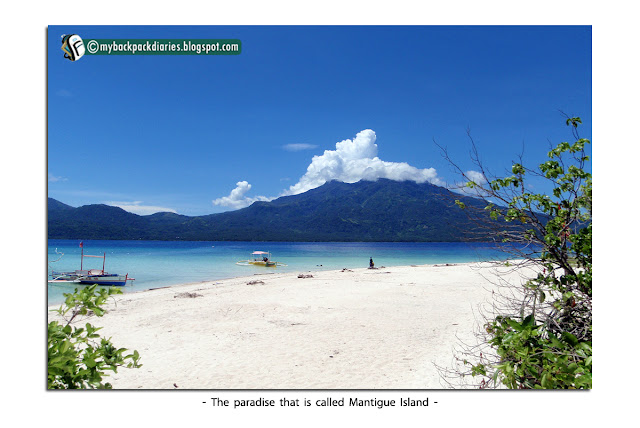Mantigue was once a fishing village until the government decided to convert it into a Marine Protected Area, imposing that no one should be living in the island. I read some accounts that villagers have relocated in the main land, either due to the government prohibiting them from staying there or due to a flooding that submerged the whole island in 6 feet deep water few years back. As I roamed around the island though, I saw several locals who seemed to go on with their daily lives. I was so curious that I asked a man, who introduced himself as the tour guide in the island, about the past situations in Mantigue. He told me that currently, there's an ongoing trial between the villagers and the government so villagers are still allowed to stay, but on the other side of the island.
Mantigue is a nature park. It has a forested area rich with different varieties of trees. A trail was established leading to the deeper part of the forest, a 383 meter area where a huge number of bats reside. We were offered by the man I asked about the situation of the island (I couldn't recall his name) to take us there for a minimal guide fee but my travel companions were too busy snorkeling that we didn't have time to do it. I couldn't blame them though since it's too hard to resist the tempting crystal clear water surrounding the island, specially when you see the life under the sea.
The island has 7.22 hectares of marine protected area. That's the part where we snorkeled. A lot of fish species can be found in the island's water. Unlike in other parts of the Philippines I've visited, fish here tend to be shy, not minding the bread we have tried feeding them. That, or the marine life is just too rich that they already get the food they need thus ignoring the bread.
It was mesmerizing to see lots of schools of fish, swimming in different directions, sometimes even bumping with the other group of fish, it was instantly an explosion of different sizes, shapes and vibrant colored sea creatures. It was indeed fascinating! Corals are also a common sight as well as sea urchins. So be extra careful.
If you're ever tired of frolicking in the water (which never happens to me) you can roam around the island bare-footed and you'd surely notice the fine white sand of the island. It shimmers in sunlight and feels soft to the skin. There are wooden tables and benches built under the shade of pandan trees ideal for picnics and cooling off from the heat of the sun. The island is a smoke-free zone.
How to Go to Mantigue Island
Getting to the island from the main land is a breeze. If you're staying in Mambajao (the capital) and is not renting a multicab, you can ride a jeep going to Benoni Port. There is a queue of jeeps right in the center of the town. Tell the driver you're alighting in Brgy. San Roque and is on your way to Mantigue Island. Fare is Php30. Upon arriving in San Roque, you'd see signs that would point you to the direction going to the boat terminal. You just need to walk for about 5 minutes.
The government has regulated the operations of these boats and they have a fixed boat fee of Php550 for the whole day. The boat can probably accommodate up to 8 people and takes about 20 minutes to get to the island. They provide life jackets for safety purposes.You will be provided a receipt before you board the boat. Upon arriving in the island, you would be asked to pay Php20 for environmental fee and a separate Php50 for snorkeling. You can just retrace your way back to Mambajao. :)
We've got lots of beautiful islands here in the Philippines and Mantigue Island definitely would be one of the finest. When you're in the province of Camiguin, don't miss your chance to experience it. :)












No comments :
Post a Comment